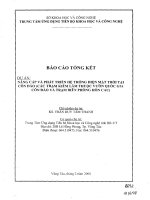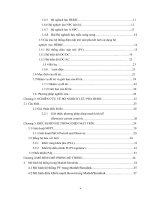MỘT PHƯƠNG PHÁP MỚI XÁC ĐỊNH VÀ DUY TRÌ ĐIỂM LÀM VIỆC CÓ CÔNG SUẤT CỰC ĐẠI CỦA HỆ THỐNG ĐIỆN MẶT TRỜI NỐI LƯỚI
Bạn đang xem bản rút gọn của tài liệu. Xem và tải ngay bản đầy đủ của tài liệu tại đây (430.56 KB, 6 trang )
<span class='text_page_counter'>(1)</span><div class='page_container' data-page=1>
<b>A NEW METHOD TO DETERMINE AND MAINTAIN THE MAXIMUM POWER </b>
<b>OPERATING POINT OF GRID -CONNECTED SOLAR POWER SYSTEM </b>
<b>Lai Khac Lai*, Danh Hoang Dang, Lai Thi Thanh Hoa </b>
<i>College of Technology - TNU </i>
ABSTRACT
Grid-connected solar power system is increasingly widely used to exploit renewable energy
sources infinite that nature presents to humans, which is solar. In this system, the maximum power
that is emit from the photovoltaic panels (PV) depends on the intensity of solar radiation and
temperature depends on the device. For each value of the intensity of solar radiation and
temperature photovoltaic panels exist a maximum power point (MPP). To enhance the
performance of the device we need to maintain the system work followed the maximum power
point when the intensity of solar radiation and temperature change on the panels. This paper
presents a method of determining and maintaining workplace that has a maximum capacity of
grid-connected solar power system with using Adaptive Neuro - Fuzzy Inference System (ANFIS).
The simulation results show that the intensity of solar radiation and various temperature changes
the working point of the system is always sticking point that with maximum power.
<i><b>Keywords: grid-connected solar power system, MPPT, ANFIS </b></i>
INITIATION *
Solar energy is one of the most important
renewable energy sources that gifted by
nature. Nowadays, one popular method to
exploit and make use of solar energy that
attracts multiple countries as well as Viet
Nam is converting them to alternate
electricity and connecting to general electrical
power grid based on power electronic
converter. That system is called grid
connected solar power system. In the grid
connected solar power system, the following
parts are included: Photovoltaic cell, DC-DC
converter, DC-AC converter, grid, maximum
power point tracking (MPPT), and controller
(Figure. 1).
<i><b>Figure 1: Diagram of the grid connected solar </b></i>
<i>power system </i>
*
<i>Tel: 0913 507464</i>
The corresponding electrical diagram of a
photovoltaic cell (PV) is indicated in Figure
2. Besides, the relation between current,
voltage, and power (I, U, and P) of a
photovoltaic cell (PV) depends on the
intensity of solar radiation and their own
temperature as explained in expression (1) [1,
2, 3,5]
s
t
U IR
AV s
ph 0
sh
U IR
I
I
I
e
1
R
<sub></sub>
<sub></sub>
<sub></sub>
(1)
where:
- Iph: photovoltaic current (A)
- I0: saturated reverse current (A)
- Rs: continous resistor of cell (Ω)
- Rsh: parallel resistor of cell (Ω)
- s c
t
N KT
V
q
- Ns: the number of continuous photovoltaic;
- K: Boltzmann constant (1.338.10-23J/0K)
- Tc: Working temperature of photovoltaic
cell (0C)
- q: charge of electronic (1,602.10-19C)
</div>
<span class='text_page_counter'>(2)</span><div class='page_container' data-page=2>
The relation I(U) and that of P(U) of
photovoltaic cell are expressed in Figure 3,
they are nonlinear relations.
<i><b>Figure 3: The relation I(U) and (U) of PV </b></i>
On the curve of P(U), an existence of a
point where the solar panel provides the
biggest power which is called the maximum
power point.
Supposing that a photovoltaic cell PV has
characteristic of I(U) and P(U) corresponding
to the defined value of solar radiation and
temperature as Figure 4, the load
characteristic of PV is a straight line 0m
crossing the origin of coordinates, the
working point of PV is the cross point
between characteristic I(U) of PV and load
characteristics of them. It is clearly seen that
if PV module working at point C, it has the
maximum power. The essence of detecting is
modifying the gradient of load characteristic
(line 0m) in such a way as to cross the curve
I(U) at point C.
<i><b>Figure 4: V-A characteristics of load and solar cell </b></i>
During operation, due to solar radiation and
the random adjustment of solar power panel
temperature, the maximum power point
(MPP) of PV is changed randomly. In order
to efficiently utilize the power produced by
solar cell at any time, the system must contain
the maximum power point tracking and
ensure that the system works at maximum
power point incessantly.
Search algorithm for maximum power point
normally carried out in DC-DC converter, for
system without DC-DC converter, MPPT is
implemented in DC-AC converter. There are
variety of researches about MPPT such as the
constant voltage method [3,4]; the disturbance
and observation methodology [4]; the
incremental conductance methodology [4];
the fuzzy control method [1, 5, 6]. In this
research, we propose a method of applying
Adaptive Neuron – Fuzzy Inference System
(ANFIS) to determine and maintain the
maximum power point for grid connected
solar power system. The following parts
present mathematic algorithm, modelling and
simulating, report and conclusion.
THE ADAPTIVE NEURON – FUZZY
INFERENCE SYSTEM
ANFIS is a combined inference between
fuzzy model Sugeno and artificial neural
network. The ANFIS bears advantages of
fuzzy system including explicit structure,
simplicity of design but benefits the advanced
priority of learning ability of Neuron network.
ANFIS has 5- class structure as Figure 5 [3].
The first class has responsibility of
fuzzilization of input variables, each of
incident function is described by one neuron,
the sharp of incident function can be either
triangle, trapezium, or Gauss function… The
output of ANFIS can be constants or linear
functions. The invisible classes 2, 3, 4 have
responsibilities of fuzzy inference, neuron in
class no. 5 finishes the defuzzilization. The
ANFIS may have multiple inputs but single
output; the output variable is determined by
expression (2)
i i
i
i i
i
i
i
w f
w f
w
<sub></sub>
(2)P, I
I(U) MPP
ISC
P(U) <sub>U </sub>
</div>
<span class='text_page_counter'>(3)</span><div class='page_container' data-page=3>
<b> </b><i><b>Figure 5: Structure of ANFIS Network</b></i>
There are two possible training algorithms for
ANFIS: Backropa and Hybrid [7].
ESTABLISHING MPPT BASED ON
ADAPTIVE NEURON – FUZZY
INFERENCE SYSTEM
In this section, authors present the algorithm
to indicate the maximum power point based
on ANFIS foundation. The major contents
include: choosing control structure,
establishing training data and verification,
installation of neuron – fuzzy network,
implementation of training and adjusting
network to achieve desired error, modelling
and simulating.
<i><b>Figure 6: Diagram of principle of grid connected </b></i>
<i>solar power system </i>
The algorithm to determine and maintain the
maximum power point is carried out by
modifying operating condition of incremental
voltage DC-DC converter. Therefore, the
output voltage and output current of solar
power panel must be measured.
The ANFIS controller has two inputs:
voltage and current of photovoltaic cell. The
output of ANFIS is brought to pulse width
modification controller (PWM) to change the
working regulation of voltage increase,
therefore, the load characteristic is adjustable
to cross the characteristic of I(U) of solar cell
at the maximum power point.
Selecting the ANFIS controller has voltage
and current inputs of photovoltaic cell. The
voltage input is fuzzilized by six series of
fuzzy which has Gauss function form, the
current input is fuzzilized by eight series of
fuzzy of Gauss function form. The incident
functions are chosen similarly and separately,
the output fuzzy is linearity. The training data
include 300 data, 200 data for inspection part.
Table 1 and table 2 illustrate several values of
training data and table 2 indicates several
values of inspection data.
<i><b>Table 1: Several values of training data </b></i>
<b>u </b> <b>i </b> <b>udk</b>
13.75167 3.747421 -3.34833
14.68876 3.746101 -2.41124
15.62247 3.717419 -1.47753
16.54304 3.635333 -0.55696
17.43195 3.456673 0.531952
16.59632 3.62848 -0.50368
16.99887 3.552842 0.098866
17.01408 3.537665 0.114079
17.29628 3.460079 0.396282
17.47939 3.391673 0.579386
17.19056 3.443852 0.29056
17.20692 3.413048 0.306918
16.97866 3.43067 0.078655
<i><b>Table 2: Several values of inspection data </b></i>
</div>
<span class='text_page_counter'>(4)</span><div class='page_container' data-page=4>
after each training period, Figure 9 and Figure
10 describe the inference function forms after
trained, Figure 11 presents the input-output
relation after being trained. It can be seen that
after training, fuzzy sets for voltage variables
rarely changed, however, a significant
modification was recorded for fuzzy sets of
current in both forms and their positions.
<i><b>Figure 7: Data sets for training and inspection </b></i>
<i><b>Figure 8: The error curve during training process </b></i>
<i><b>Figure 9: The inference functions of voltage </b></i>
<i>variable after being trained </i>
<i><b>Figure 10: The inference function of current </b></i>
<i>variable after being trained </i>
<i><b>Figure 11: The input-output relation of ANFIS </b></i>
<i>after training </i>
<i><b>Table 3: Parameters of photovoltaic cell </b></i>
<b>Parameter </b> <b>Values </b>
The number of cell pin (cell pin) 72 cell
Alternate range of solar
radiation
from (800 –
1000)W/m2
Operating temperature of solar cell 250C
Parallel resistor of solar cell 1000Ω
Continuous resistor of solar cell 0,008Ω
Short-circuit current 3,8A
Saturated current of diot (Is0) 2.10-8A
Energy band Eg 1,12
Form factor A 1,2
Temperature affection coefficient 0,0024
SIMULATION RESULTS
</div>
<span class='text_page_counter'>(5)</span><div class='page_container' data-page=5>
voltage of voltage increase is 300V, the
structure of Matlab simulation is shown in
Figure 13 and that of Psim is presented in
Figure 14.
t
To Workspace1
y
To Workspace
Scope
u
i
Gate
PSIM
Fuzzy Logic
Controller
Clock
<i><b>Figure 12: Diagram of simulation in Matlab </b></i>
<i><b>Figure 13: Structure of simulation in Psim </b></i>
<i><b>Figure 14: Dynamic response of system </b></i>
Remark: The simulation results show on the
figure 14 that the MPPT algorithm ensures
the solar power system tracking the maximum
power point while the solar radiation
modifying.
CONCLUSION
Applying Adaptive Neuron-Fuzzy Network is
able to train in order to implement
determination algorithm and maitainance of
the maximum power operating point of grid
connected solar power. The simulation results
obatained from Matlab-Simulink and Psim
indicate that our proposed method is feasable.
REFERENCES
1. Le Thi Minh Tam, Nguyen Viet Nhu, Nguyen
Van Duong, Nguyen Thanh Tien, (2015), “A
proposed maximum power point tracking method
for photovoltaic based on variable structure fuzzy
<i>control”; Proceeding of science workshop of </i>
<i>TNUT.</i>
2. Lai Khac Lai "Fuzzy Logic Controller for
<i>Grid-Connected single phase Inverter", Journal of </i>
<i>Science and Technology - Thai Nguyen University </i>
No:02.2013
3. M.B. Eteiba, E.T.EI Shenawy, J.H Shazly, A.Z.
Hafez, (2013), “A photovoltaic (Cell, Module,
Array) Simolation and Monitoring Model using
<i>MATLAB/GUI Interface”, International Journal </i>
<i>of computer Application (0975-8887), vol 69, May </i>
3. Haruil Nissah Zainudin, Saad Mikhilef
“Comparision Study od Maximum Poer Point
<i>Tracker Tecnique fo PV Dystems” Proceeding of </i>
<i>the Middle East Power System Conference </i>
<i>(MEPCON’10), </i> Cairo University, Egypt,
December 19-21, Paper ID278
4. Ricardo Antonio-Mendez, Jesus de la
Cruz-Alejo and Ollin Peñaloza-Mejia, (2014), “Fuzzy
Logic Control on FPGA for Solar Tracking
System", Proceedings of the musme conference
held in Huatolco, Mexico, October 21-24,
5. Dipti Bawa, C.Y. Patil Department of
Instrumentation and Control, College of
Engineering, Pune “Fuzzy control based solar
tracker using Arduino Uno” International Journal
of Engineering and Innovative Technology (IJEIT)
Volume 2, Issue 12, June 2013
</div>
<span class='text_page_counter'>(6)</span><div class='page_container' data-page=6>
TÓM TẮT
<b>MỘT PHƯƠNG PHÁP MỚI XÁC ĐỊNH VÀ DUY TRÌ ĐIỂM LÀM VIỆC CĨ </b>
<b>CƠNG SUẤT CỰC ĐẠI CỦA HỆ THỐNG ĐIỆN MẶT TRỜI NỐI LƯỚI </b>
<b>Lại Khắc Lãi*<sub>, Đặng Danh Hoằng, Lại Thị Thanh Hoa </sub></b>
<i>Trường Đại học Kỹ thuật Công nghiệp – ĐH Thái Nguyên </i>
Hệ thống điện mặt trời nối lưới đang ngày càng được sử dụng rộng rãi để khai thác nguồn năng
lượng tái tạo vô hạn mà thiên nhiên ban tặng cho con người, đó là năng lượng mặt trời. Trong hệ
thống này, công suất cực đại do các tấm pin quang điện (PV) phát ra phụ thuộc vào cường độ bức
xạ của mặt trời và phụ thuộc vào nhiệt độ làm việc của thiết bị. Ứng với mỗi giá trị của cường độ
bức xạ mặt trời và nhiệt độ tấm pin quang điện, có một điểm cơng suất do tấm pin phát ra là lớn
nhất, gọi là điểm có công suất cực đại (MPP). Để nâng cao hiệu suất của thiết bị thì cần phải duy
trì hệ thống làm việc bám theo điểm có cơng suất cực đại khi cường độ bức xạ của mặt trời và
nhiệt độ tấm pin thay đổi. Bài báo này trình bày một phương pháp xác định và duy trì điểm làm
việc có cơng suất cực đại của hệ thống điện mặt trời nối lưới bằng cách sử dụng bộ điều khiển nơ
ron - mờ thích nghi (ANFIS). Kết quả mô phỏng cho thấy với các cường độ bức xạ mặt trời và
nhiệt độ thay đổi khác nhau điểm làm việc của hệ thống ln bám điểm có cơng suất cực đại.
<i><b>Từ khóa: Điện mặt trời nối lưới, MPPT, Anfis </b></i>
<i> </i>
*
</div>
<!--links-->









